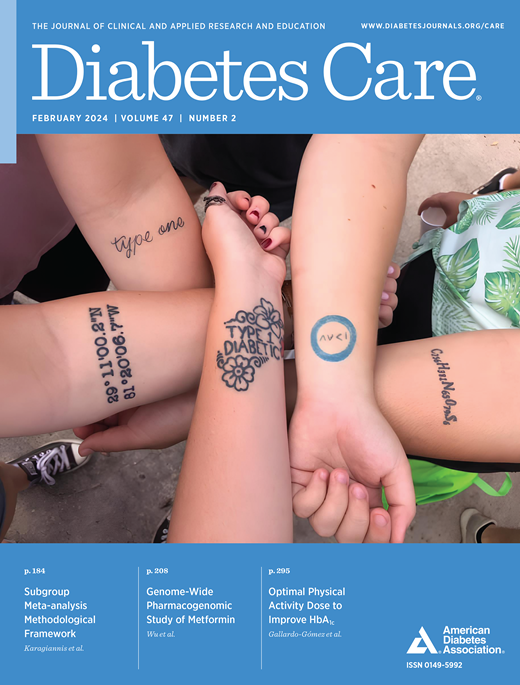Circulating Metabolite Biomarkers of Glycemic Control in Youth-Onset Type 2 Diabetes
IF 14.8
1区 医学
Q1 ENDOCRINOLOGY & METABOLISM
引用次数: 0
Abstract
OBJECTIVE We aimed to identify metabolites associated with loss of glycemic control in youth-onset type 2 diabetes. RESEARCH DESIGN AND METHODS We measured 480 metabolites in fasting plasma samples from the TODAY (Treatment Options for Type 2 Diabetes in Adolescents and Youth) study. Participants (N = 393; age 10–17 years) were randomly assigned to metformin, metformin plus rosiglitazone, or metformin plus lifestyle intervention. Additional metabolomic measurements after 36 months were obtained in 304 participants. Cox models were used to assess baseline metabolites, interaction of metabolites and treatment group, and change in metabolites (0–36 months), with loss of glycemic control adjusted for age, sex, race, treatment group, and BMI. Metabolite prediction models of glycemic failure were generated using elastic net regression and compared with clinical risk factors. RESULTS Loss of glycemic control (HbA1c ≥8% or insulin therapy) occurred in 179 of 393 participants (mean 12.4 months). Baseline levels of 33 metabolites were associated with loss of glycemic control (q < 0.05). Associations of hexose and xanthurenic acid with treatment failure differed by treatment randomization; youths with higher baseline levels of these two compounds had a lower risk of treatment failure with metformin alone. For three metabolites, changes from 0 to 36 months were associated with loss of glycemic control (q < 0.05). Changes in d-gluconic acid and 1,5-AG/1-deoxyglucose, but not baseline levels of measured metabolites, predicted treatment failure better than changes in HbA1c or measures of β-cell function. CONCLUSIONS Metabolomics provides insight into circulating small molecules associated with loss of glycemic control and may highlight metabolic pathways contributing to treatment failure in youth-onset diabetes.青年 2 型糖尿病患者血糖控制的循环代谢物生物标志物
目的 我们旨在确定与青少年 2 型糖尿病患者血糖失控有关的代谢物。研究设计与方法 我们测量了 TODAY(青少年 2 型糖尿病治疗方案)研究中空腹血浆样本中的 480 种代谢物。参与者(N = 393;年龄 10-17 岁)被随机分配到二甲双胍、二甲双胍加罗格列酮或二甲双胍加生活方式干预。304名参与者在36个月后接受了额外的代谢组测量。Cox模型用于评估基线代谢物、代谢物与治疗组的交互作用以及代谢物的变化(0-36个月),血糖控制的丧失按年龄、性别、种族、治疗组和体重指数进行了调整。使用弹性净回归法生成血糖失效的代谢物预测模型,并与临床风险因素进行比较。结果 393 名参与者中有 179 人血糖失控(HbA1c ≥8% 或胰岛素治疗)(平均 12.4 个月)。33 种代谢物的基线水平与血糖失控相关(q < 0.05)。正己糖和黄嘌呤核酸与治疗失败的关系因治疗随机化而异;这两种化合物基线水平较高的青少年单用二甲双胍治疗失败的风险较低。就三种代谢物而言,从 0 个月到 36 个月的变化与血糖控制的丧失有关(q < 0.05)。d-葡萄糖酸和1,5-AG/1-脱氧葡萄糖的变化(而非所测代谢物的基线水平)比 HbA1c 或 β 细胞功能指标的变化更能预测治疗失败。结论 代谢组学有助于深入了解与血糖控制失效相关的循环小分子,并可突出导致青年糖尿病治疗失败的代谢途径。
本文章由计算机程序翻译,如有差异,请以英文原文为准。
求助全文
约1分钟内获得全文
求助全文
来源期刊

Diabetes Care
医学-内分泌学与代谢
CiteScore
27.80
自引率
4.90%
发文量
449
审稿时长
1 months
期刊介绍:
The journal's overarching mission can be captured by the simple word "Care," reflecting its commitment to enhancing patient well-being. Diabetes Care aims to support better patient care by addressing the comprehensive needs of healthcare professionals dedicated to managing diabetes.
Diabetes Care serves as a valuable resource for healthcare practitioners, aiming to advance knowledge, foster research, and improve diabetes management. The journal publishes original research across various categories, including Clinical Care, Education, Nutrition, Psychosocial Research, Epidemiology, Health Services Research, Emerging Treatments and Technologies, Pathophysiology, Complications, and Cardiovascular and Metabolic Risk. Additionally, Diabetes Care features ADA statements, consensus reports, review articles, letters to the editor, and health/medical news, appealing to a diverse audience of physicians, researchers, psychologists, educators, and other healthcare professionals.
 求助内容:
求助内容: 应助结果提醒方式:
应助结果提醒方式:


